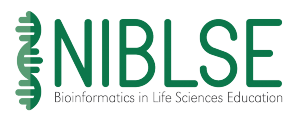Bring Bioinformatics to Your Biology Classroom
Selected Modules
Please see CourseSource for a more polished version of the modules and an associated manuscript describing the utility of the modules and how they can be implemented in the classroom.
The following modules are from a preprint version of the "Sequence Similarity: An inquiry based and "under the hood" approach for incorporating molecular sequence alignment in introductory undergraduate biology courses" learning resource published in CourseSource.
These are the selected modules for this Faculty Mentoring Network (FMN). During the Spring 2019 semester, participants will adapt and implement at least one of the following guided inquiry modules into their classrooms. The other guided inquiry modules as well as a range of open ended inquiry modules will also be available for implementation. All three guided inquiry modules are packaged together in a single document (S1. student_handout.docx) along with supplementary materials for the modules (S2-S11). All materials are available for download via this link.
- Module 1: Similarity and Sequence Alignment
- Students start this module by exploring the meaning of sequence similarity and then investigate how similarity can be quantitatively compared between two similar length proteins using a Blocks Substitution Matrix (BLOSUM) scoring matrix. Student understanding of this core concept and competency has utility for biologists seeking to identify conserved blocks of sequence in homologous proteins that may have structural and functional importance and hint at evolutionary relationships between two sequences. Download the exercise bundle and see “Exercise 1” within document S1 to preview this module.
- Module 2: Sequence Alignment to a Database of Sequences
- Students find local regions of similarity between a query sequence and a database of subject sequences using the Basic Local Alignment Search Tool (BLAST) algorithm. Student understanding of this core concept and competency has utility for biologists seeking to identify conserved blocks of nucleotide or protein sequence that may or may not necessarily be homologous, but share common domains (often reused by similar families of proteins) that may hint at structure and function of a protein and hint at evolutionary relationships between two sequences. Download the exercise bundle and see “Exercise 2” within document S1 to preview this module. Document S3 should be used as a class handout for students to simulate how the BLAST algorithm extends alignments from an initial set of seed words.
- Module 3: Phylogenetic Analysis of Homologous Sequences
- Students practice accessing text-based FASTA-formatted sequence information via National Center for Biotechnology Information (NCBI) databases as they collect protein sequence data for a multiple sequence alignment for the generation of a phylogenetic tree. Student understanding of this core concept and competency has utility for biologists seeking to identify conserved protein domains and often key conserved amino acid residues associated with structure and function within a domain in addition to allowing for visual depiction of evolutionary relationships between three or more sequences. Download the exercise bundle and see “Exercise 3” within document S1 to preview this module. Document S4 should be used as a class handout for students to calculate individual pairwise sequence alignments to simulate the generation of a distance matrix by a multiple sequence alignment algorithm. Document S5 should be used as a class handout for students to simulate the neighbor-joining algorithm for generating a phylogram.
